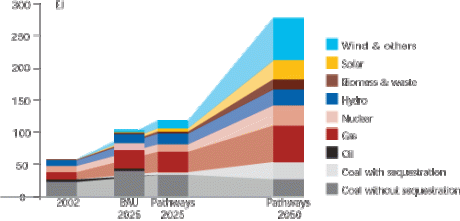Pathways to 2050 – towards an ‘all’ electrical society May 10, 2006
Posted by Hans De Keulenaer in carbon management, efficiency, nuclear, renewable electricity, roadmap, security.add a comment
Challenging climate change caused by carbon emissions is such a many-sided problem, involving many actors from all over the world, that it is absolutely necessary to set clear and realistic goals. That is what the World Business Council for Sustainable Development (WBCSD) did in its paper Pathways to 2050 (pdf – 3 MB).
The WBCSD unites 180 international companies who share the commitment to sustainable development through economic growth, ecological balance and social progress. In their paper on energy and climate change (December 2005), they describe three paths to 2050.

Business as usual
If we don't react, global carbon emissions will rise from 7.8 Gigatons in 2002, to some 12 Gt in 2030 and 15-16 Gt by 2050. In that case, the atmospheric CO2 concentration will rise up to 1,000 ppm. The resulting temperature rise cannot be predicted accurately, but it might be as high as 3-4°C by 2100 and up to 6°C by 2300. It goes without words that such an enormous temperature rise will have far-reaching consequences.
An optimistic scenario
A figure that is sometimes postulated is to reduce the global carbon emissions to half of its current value. In that case, the carbon concentration is expected to rise to 450 ppm, causing a temperature rise of 1 up to 2.5 degree C by 2100. Bearing in mind that the global energy demand will at least double, even if we put a lot of effort in energy efficiency, this is clearly an optimistic scenario that would require far more drastic measures than the ones we are applying today.
A realistic scenario
More realistic would be – according to the WBCSD – to bring back the carbon emissions to the current value by 2050. This would limit the atmospheric concentration to 550 ppm and the temperature rise to 1,5 up to 3° C by 2100. It would allow carbon emissions to increase in the medium term, and require a global downturn by 2025, followed by a continuous decline. Realistic but ambitious, this scenario would still require sectorial shifts and significant changes in energy production and use.
The energy mix for electricity production
In the realistic scenario, the WBCSD sees the share of electricity in the total energy consumption double by 2050. The growing importance of electricity is the result of following trends:
- improvements in electrical applications, and substitution of fossil fuels in end use
- increasing number of electrical appliances
- information technology and the internet
- urbanisation

Since the total energy consumption itself is expected to double by 2050, this means that the electricity production should quadruple. The energy mix for the power generation could be as follows:

| Source | % in mix | Growth compared to 2002 |
| Wind (+ geothermal, tidal, and wave energy) | 25% | x 160 |
| Solar | 12% | x 300 |
| Biomass and waste | 5% | x 18 |
| Hydro | 8% | x 2 |
| Nuclear | 10% | x 2 |
| Natural Gas | 20% | x 3 |
| Coal with Carbon Capture and Storage | 20% | x 2 |
Half of the electricity production will come from renewable sources. To realize this, solar, wind and biomass should see a very steep and continuous growth. Mind that coal fired power stations are still in the mix, but are equipped with Carbon Capture and Storage (CCS) systems. Also nuclear energy is still growing according to this scenario, meaning that the currently operating plants will have to be replaced and new capacity should be installed.